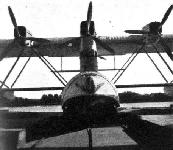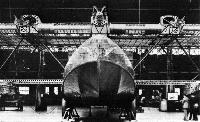
Flight, August 1932
The Bleriot Transatlantic Seaplane
THE Bleriot Co. are building a large seaplane at their shops at Suresnes (Paris Suburb), intended for transatlantic operation. It has a wing span of 141 ft. (43 metres), will be equipped with four Hispano-Suiza 650-h.p. water-cooled engines, and will weigh some 22 tons, when loaded ready for flight. The plans have been prepared by Philip Zapata, the engineer who also designed the Bleriot 110, the plane with which Bossoutrot and Rossi recently established a new world's long-distance continuous flight closed circuit record.
This new seaplane has been ordered by the French Government, and is intended for operation on the South Atlantic section, Dakar to Natal, of the Aeropostale France-South American air mail route. This ocean crossing is some 3,000 kilometres (nearly 2,000 miles) in length and is now operated by fast light steamers, which cover the distance in about 100 hours (four days). It is expected that this Bleriot-Zapata seaplane will have a cruising speed of about 170 to 180 km./hr. (106 to 112 m./hr.) and thus should make the crossing in about 20 hr. A saving of at least three days will thus be effected in the schedule of this air mail route, which now takes 8 to 9 days to cover the distance between Toulouse, France and Buenos Aires.
This new machine, which is rapidly nearing completion, is a high-wing monoplane equipped with a strong seagoing hull and with lateral pontoons or floats. The hull is constructed of duralumin plates, the maximum thickness of which is 2 1/2 millimetres, while the keel has two steps to facilitate the taking off. The pontoons also have steps.
Mounted above the centre of the hull is a rectangular super-structure, 13 ft. (4 metres) long, 4 ft. (1.20 m.) wide, and of a height of about 8 ft. (2.50 m.). It will contain the quarters for the crew and radio installation, the pilot being installed in the front part of it and thus having excellent visibility.
The wings comprise a centre section, forming part of the top superstructure, and to which the main wings are joined. They are braced to the hull by two steel struts mounted on each side of the super-structure at an angle of 45 deg. The construction consists of two main wing spars, with the usual interior bracing. The wings have a rectangular plan-form for about half their length and then taper off elliptically towards their ends. Their thickness varies from one to about three feet. They are covered with fabric and mounted at a dihedral angle of 1.30 deg.
The pontoons have a volume of 3 cu. m. (106 cu. ft.) each. They are held in position by four struts braced to the wing above them and mounted in pairs at 90 deg. to each other. The pontoons are further braced by two light beams securing them to the hull.
The seaplane will be equipped with four 650-h.p. Hispano-Suiza water-cooled engines (of the type used by Dieudonne Costes in his 1930 transatlantic flight) fitted with reduction gears. Two of these engines will be mounted in tandem, the one on the leading edge and the other on the trailing edge of the centre section of the wings and directly over the superstructure. The two other engines will be mounted in the leading edge of the wings on each side of the centre motor, at the points where the wing and pontoon struts meet. Owing to the thickness of the wings it will be possible to carry out repairs to the engines during flight. The fuel tanks, installed in the hull, are 16 in number, with a capacity of 750 litres (165 gallons) each, making a total fuel supply of 11,000 litres (2,425 gallons).
Transporting a commercial load of 600 kg. (1,323 lb.), this machine will thus have a flight radius of 5,000 km. (3,107 miles) under the conditions of no wind prevailing. With a headwind of 50 km./hr. (31 m./hr.) prevailing, this plane should have a flight radius of 3,200 km. (nearly 2,000 miles). It is expected that the machine will take off and fly on three motors and maintain its altitude on two engines.
The crew will consist of four men, a commander, two pilots and a mechanic. A temporary landing gear has been fitted to the machine to facilitate its handling before it leaves the shops. It is expected that it will be completed and turned over to the Government at the end of this year.
The main characteristics of this seaplane are: Wing span, 43 metres (141 ft.). Height, 6.9 m. (22 ft. 7 in.). Length, 26 m. (85 ft. 4 in.). Width of hull, 3.64 m. (12 ft.). Wing surface, 222 sq. m. (2,388 sq. ft.). Nominal power of engines, 2,600 h.p. Maximum power of engines, 3,000 h.p. Weight of plane (empty), 11,200 kg. (24,696 lb.). Weight of plane (loaded), 22,000 kg. (48,500 lb.). Maximum speed, 220 km./hr. (136.7 m./hr.). Cruising speed, 175 km./hr. (109 m./hr.). Flight radius (no wind prevailing), 5,000 km. (3,107 miles). Flight radius (head wind 50 km./hr. prevailing), 3,200 km. (2,000 miles).
Описание:
- Flight, August 1932
The Bleriot Transatlantic Seaplane - Flight, August 1933
THE BLERIOT 5190
Фотографии
-
Flight 1933-08 / Flight
THE BLERIOT 5190: The machine on the slipway.
-
Flight 1933-08 / Flight
STRUT BRACING: The engines are Hispano-Suiza of 650 h.p.
-
Flight 1932-08 / Flight
A front view of new Bleriot Seaplane type 5190 now rapidly nearing completion.
-
Flight 1932-08 / Flight
The Type 5190 Bleriot Seaplane for Transatlantic Service. It is fitted with four 650-h.p. Hispano-Suiza engines - only one of which is shown in place in the illustration.
-
Flight 1937-10 / Flight
Bleriot 5190 Santos Dumont.
-
Flight 1933-08 / Flight
Bleriot B.5190 4 Hispano-Suiza 12 Nbr. Engines
- Фотографии





